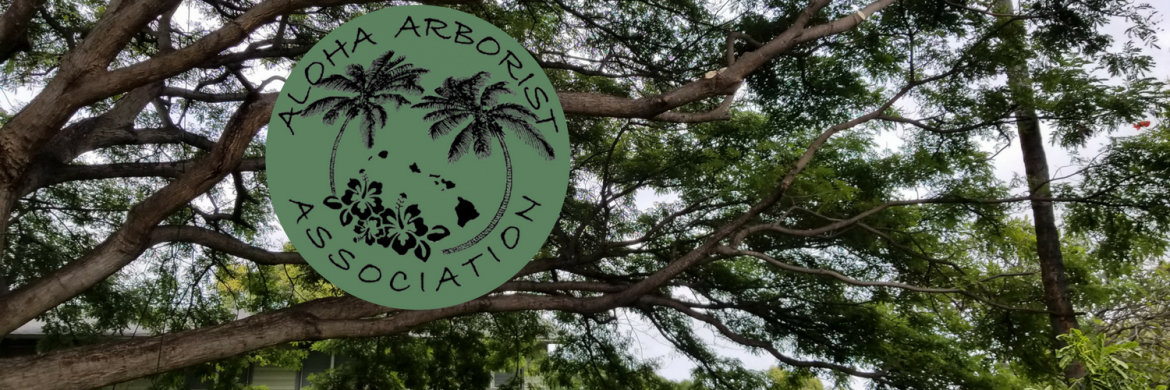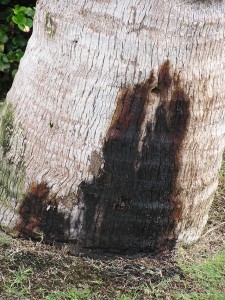Hosts: Primarily affects coconut palms (Cocos nucifera) Symptoms: Loss of young fruits, brown mottling on immature and mature green fruits, heart rot of plant evident when youngest spear leaf dies, leaf death, death of palm Spread: Via movement of infected nuts and palms, pruning with contaminated equipment, insects, rodents, wind-driven rain Control: Remove and incinerate …
Category: Pests
AAA shares pest information regularly, so that industry professionals and the public can stay informed and help protect Hawaii's trees.
Jun 20
Pest of the Month July 2009 – Cassytha filiformis
Hosts: Mainly woody species including native and naturalized coastal hosts such as tree heliotrope, beach naupaka, ohia lehua, noni, and hala. Habitat: Primarily coastal areas, all major islands except Kaho’olawe. Requires full sun. This species is indigenous toHawaii. Effects: Parasitic. Infections can be fatal to host species. Treatment/prevention: (1) Remove (prune) infected limbs as early …
Jun 20
Pest of the Month June 2009 – Naio Thrips
Hosts: Many species of Myoporum will likely be susceptible. In Hawaii, naio thrips have been observed attacking both the prostrate (naio papa) and upright forms of the indigenous Myoporum sandwicense. Distribution: Northwestern part of the Island of Hawaii. Damage: Severe gall-like distortion of the new leaves and terminals. Stunting of terminal growth and leaf curling …
Jun 20
Pest of the Month May 2009 – Hawaiian Mistletoes
Hosts: Native hardwoods Distribution: Varies by species – see table p. 3 of source document Management: Prune affected branches and destroy them (do not use as mulch). Limit management to high-value forestry or landscape settings since these plants have a useful part in Hawaii‘s ecosystem. Source: Hawaiian Mistletoes (Korthalsella Species), Dr. Scot Nelson and Dr. …
Jun 20
Pest of the Month March 2009 – Red Palm Mite (Pest Alert)
Description: Red Palm Mite (RPM) is a bright red mite with long body hairs, usually with a drop of liquid at the tip of the hair. The body is flat. Range: Native to tropical and subtropical southeast Asia and the Middle East. Expanded range includes Caribbean Islands and Florida. Pathways: Extremely easy to spread. Can …
Jun 20
Pest of the Month February 2009 – Stem Bleeding of Coconut
Cause: Chalara paradoxa, a mainly soilborne plant-pathogenic fungus Hosts: Areca catechu, Barhea edulis, Caryota spp., Cocos nucifera, Elaeis guineensis, Phoenix africanus, Phoenix canariensis, Phoenix dactylifera, Raphis sp., Roystonea elata, Sabal palmetto, Sygarus romanzoffinia, Washingtonia filifera Symptoms: black stain coming from a hole or wound and seeping down the coconut stem Management: Prevention and avoidance – don’t …
Jun 20
Pest of the Month January 2009 – Plumeria Rust
Distribution: Main Hawaiian Islands Host: Plumeria spp. Symptoms: Powdery, yellow-orange lesions on leaves with powdery spore masses on the underside of leaves Management: Plant resistant species or hybrids, leaf litter control/destruction, plant in drier areas, apply approved fungicides when necessary, biological control with fungal hyperparasites and an insect (midge) predator, control weeds to improve airflow, …
Jun 20
Pest of the Month November 2008 – Cycad Scale
Distribution: Oahu, Big Island, Kauai, and Maui Host: Cycad species especially sago palm Symptoms: Leaves turn yellow, then brown and die Management: Biological control with tiny black lady beetle (Rhyzobius lophanthae) preferred. Source: Cycad Scale on Sago Palm, University of Hawai’i at Manoa, College of Tropical Agriculture and Human Resources, Cooperative Extension Service, Publication IP-23, October …
Jun 20
Pest of the Month October 2008 – Coconut Rhinoceros Beetle (Pest Alert)
Distribution: South Pacific (American Samoa, others) Host: Coconut palm, oil palms, other palm species Symptoms: V-shaped cuts in the fronds or holes through the midrib Management: Eliminating the places where they breed and manually destroying adults and immatures. Also through natural enemies such as pigs, rats, ants, and some beetles and diseases (fungus Metahizium anisopliae …
Jun 20
Pest of the Month August 2008 – Sudden Oak Death (Pest Alert)
Distribution: Western U.S.–California, Oregon, Washington, British Columbia Hosts: 38 species susceptible, additional 16 species associated with disease. Deadly to beech and oak. Hawaiian Islands associated hosts include Camellia, Rhododendron, and Victorian laurel Symptoms: Canker on trunk, may be oozing. If plants showing symptoms are found, call 643-PEST from any island in Hawaii. Control: Clear cutting, burning, …

